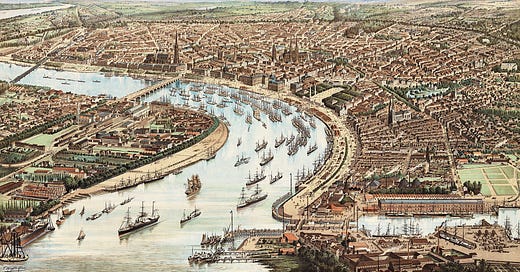I’ve spent a bit of time in Bordeaux, and wanted to document some random thoughts about it. Bordeaux is France’s sixth largest city. The size of french cities falls off quickly after Paris (pop. 13 million): the Bordeaux metro area (the broadest definition) holds 1.4 million residents.
Bordeaux is an old city. The city center is still shaped by where Medieval walls once stood, and one of the landmarks, “La grosse cloche”, marks the entrance to the once-walled city. Nowadays, it’s mostly old buildings, there isn’t much “castle” to be seen. But the imprints of medieval origins are evident.
First, the streets are narrow, often with a single lane, and move irregularly, forming a maze-like street network that seems like a recipe for gridlock and congestion. But it isn’t. Really, the most surprising part of Bordeaux’s streets is the lack of cars at all. Of course, some parts are explicitly pedestrianized, usually with retractable bollards allowing commercial deliveries. But many streets within the old city allow cars but have low traffic, why?
Demand Destruction
Just like oil moving through a pipeline, car traffic flow is limited by the lowest capacity segment (the bottleneck). In North America, transport planning often tries to solve those bottlenecks, or move them as close to the downtown as possible (see my last city series on Hartford as a example). But what if you didn’t? Looking at Bordeaux’s road network, there aren’t good high capacity roads to get into the city (even the roads in yellow are boulevards with stoplights). The lack of road capacity prevents many trips from outside-in, almost like walls against road traffic.
In addition, parking seems like a genuine nightmare - stalls are sparse (the buildings are mostly pre-car!) and street parking is nearly all accounted for by vans and a few residents. It reminds me of the Yogi Berra classic:
Instead, folks mostly rely on a network of trams and bus lanes, cycling, and a lot of walking to get around. But quite paradoxically, if you are in the old city, getting around by car is quite efficient! Although the street network is jagged, there is almost no congestion, which makes the odd uber ride relatively smooth.
Mec, c’est où ma maison?
The other fascinating part of Bordeaux is the housing dynamics. The government and folks have clearly decided that the existing 3-4 storeys in the old city is “good enough”, and to not allow any higher buildings. Clearly, that is a hard limit. And although Bordeaux packs moderate density at 5,300 people per square km (40% more than the Halifax peninsula), a firm stance against going up is a big brake on growth.
But “the old world” just doesn’t have the growth trends that Canada does. The city of Bordeaux’s population stopped growing at the turn of the century… the turn of the 20th century.
Being super-restrictive on housing in a slow or no growth market does not need to be recipe for disaster. In many ways, Halifax had a similar experience for several decades leading up to 2015, a very brittle housing market was mostly fine because growth was modest (by Canadian standards).
Now, I’ve only been talking about Bordeaux itself, which is a narrow definition of the city. And while the entire province (Nouvelle-Aquitaine) has only grown by 0.5% per year since 1975, there is still a need to build (more folks living alone and such). But that’s not happening in the old city, but instead on its outskirts1.
Taking the tram out to the football stadium, I crossed long stretches of newish neighborhoods that would not at all “fit” in the old city, with more currently under construction.
Setting aside the question of whether it’s right to only build density on the outside of the city core, I wondered: how do they get all the land together?
Which leads to another advantage of old cities: huge plots of (often empty) industrial lands inside of or close to cities. Bordeaux is on the Garonne, with easy access to the Atlantic ocean, so it’s historically had a strong shipping industry. Those docks and warehouses provide bulk land from which a city planner plan a functional medium density neighborhood. It’s a big advantage over newer Canadian cities (our closest analogy would probably be our shopping malls).
My main takeaway is that slow-growth countries can get away with slow-growth policies, and a lot of Canada’s housing challenges come from trying to combine slow-growth planning policy with high population growth.
That also applies to a lot of office buildings. It also leads to the reverse of North American city cores: a lively downtown during the night and weekends, as folks come in to enjoy restaurants such, but they are relatively calm during a workday










Deny, "Nobody wants to pay taxes because it to easy to keep on spending'....Lets build on abandon schools and churches. "After we pay for the first floor the rest is free"